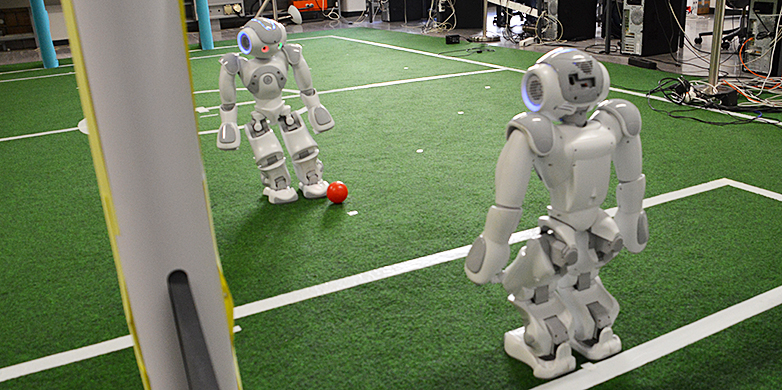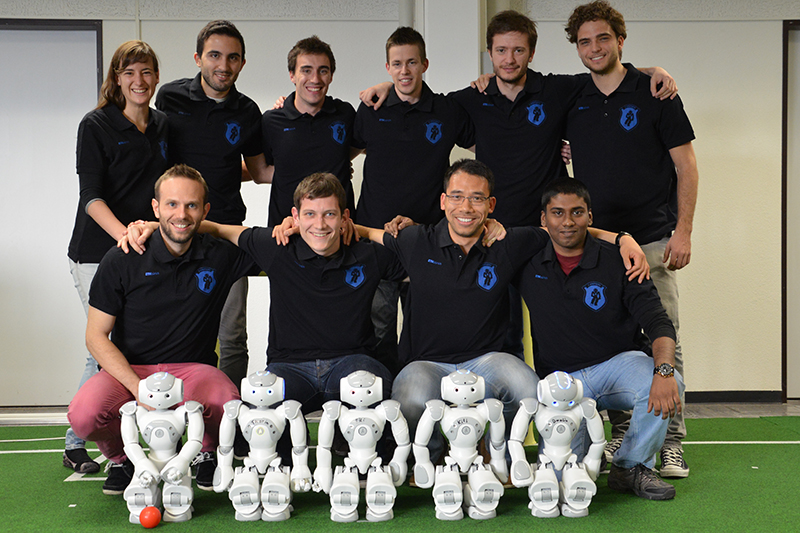Robots go for goal
Students from ETH Zurich made their debut at the Standard Platform League’s Robocup, a football championship for robots, this year. Their “dwarves” put in a solid performance.
They are called Kili, Fili, Thorin or Dwalin, after the dwarves from Tolkien‘s The Hobbit – and are the same size as dwarves, too. But unlike the film and book heroes, they are made of plastic and have eyes that light up in all the colours of the rainbow and a computer brain. And they play football – or rather are programmed to do so by students from ETH Zurich. As a nod to their goal-scoring skills, the football team is called “Z-Knipsers” (The Poachers). “A poacher hangs around in the penalty box and taps in important goals,” says Master’s student Huub Heijnen, who was involved in the Robocup project, with a wink.
At the end of last week, the Z-Knipsers and their handlers – eight undergraduates and three doctoral students from the Department of Information Technology and Electrical Engineering (D-ITET), Departement of Computer Science (D-INFK) and Department of Mechanical and Process Engineering (D-MAVT) – made their way to Magdeburg to make their debut appearance at the Robocup German Open, pitting their wits against eight other teams from all over Europe and Iran in the external pageStandard Platform Leaguecall_made (SPL).
Valuable experience
“For the team, it was an exciting experience with many impressive moments,” says Khoa Nguyen, a doctoral student from the Automatic Control Lab under Professor John Lygeros and Professor Manfred Morari and the Z-Knipsers’ coach. The robots took up their positions on the field by themselves and fought bravely for the ball. Unfortunately, they failed to win any of their four group games. However, the silver lining was the fact that the Z-Knipsers improved with every game, with the students working on these improvements well into the night. “The robots went for the ball with greater determination, shot more powerfully and the goalie learned a new technique,” reports Nguyen on the progress.
The Z-Knipsers also received encouraging feedback from the Robocup community. For a debut tournament appearance, their performance was remarkable, especially given the fact that the ETH-Zurich team has only been working with these standard platform robots for just under three years – not very long compared to other teams, who have been contesting the Robocup for a decade. Never having competed before, the Z-Knipsers lack experience.
Lean codes
In the SPL category of the Robocup, all teams play with robots that are identical in terms of their construction. What makes the difference is the algorithms that the students programme and implant in the robots’ heads via a network or Wifi interface. As the computer in the robots’ heads is about as powerful as those found in your average Smartphone, the challenge is to make the codes as lean as possible. Despite the limited computational power, they have to be efficient and able to regulate the complex behaviour and perception of the wireless, autonomous robots. The speed at which a footballer moves across the field is also programmed. And if a robot falls over, it is supposed to be able to get back up by itself.
For Gemma Roig, a doctoral student at Professor Luc van Gool’s Vision Lab von and supervisor of the ETH-Zurich team, the football robots are an ideal learning tool to teach students different concepts of computer-aided visual perception and automation.
“In the beginning, our robots played really badly and there was absolute chaos on the pitch,” she says. “In the past year, however, we especially made major progress in the visual system, which is why we decided to enter the competition.”
Robot footballers a semester project
Every team member was given a particular task, such as programming the defender or goalie from scratch to behave correctly in a free-kick situation. Another task was to implement active vision and head movements. And one team member created a computer simulation to help lift the robots to peak form on the screen.
Bachelor’s and Master’s student work on the sub-projects, which, for most of them, constitute their term paper. After a season, however, most of the team members bow out. To make sure that the knowhow remains intact, the Z-Knipsers have a Wiki entry and an electronic file, where they store algorithms and programmes.
After their promising debut at the Robocup, the Z-Knipsers have set the bar higher for future competitions. The team’s next goal is to qualify for the World Cup. “Until then, we’ll keep on testing our footballers painstakingly and ironing out any weaknesses, especially regarding self-localisation, speed and shooting power,” sums up Nguyen.


